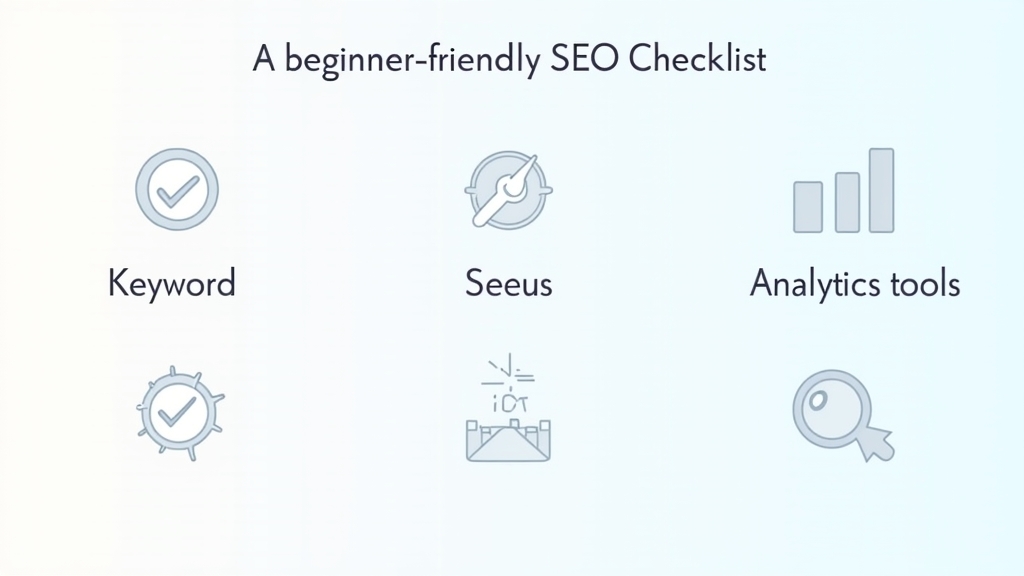Marketing: SEO Checklist for Beginners
Introduction
Search Engine Optimization (SEO) is a crucial part of digital marketing that helps your website rank higher on search engines like Google. This means more visitors, more engagement, and potentially more sales for your business. If you’re just starting out in the world of SEO, this checklist is designed specifically for you. It will guide you through the essential steps to improve your online presence and make sure you’re not missing any important details.
Understanding SEO Basics
What is SEO?
SEO stands for Search Engine Optimization. It involves various strategies and techniques aimed at improving your website’s visibility on search engines. When someone searches for something related to your business, good SEO practices help ensure that your site appears near the top of the results. This can lead to increased traffic and greater brand awareness.
Why is SEO Important for Businesses?
SEO is vital because it directly impacts how easily potential customers can find you online. With effective SEO, businesses can attract organic traffic without having to pay for ads. Additionally, a well-optimized site enhances user experience, builds credibility, and establishes trust with users—all key factors in converting visitors into customers.
Keyword Research Essentials
Tools for Keyword Research
Keyword research tools are essential for identifying what terms people use when searching online. Some popular tools include Google Keyword Planner, Ahrefs, and SEMrush. These tools provide insights into keyword volume, competition level, and related keywords that can help you target the right audience effectively.
How to Choose the Right Keywords
When selecting keywords, focus on relevance to your content and audience intent. Look for keywords with a balance between high search volume and low competition. Long-tail keywords—phrases that are longer but more specific—can also be beneficial as they often convert better due to their specificity.
On-Page SEO Techniques
Optimizing Title Tags and Meta Descriptions
Title tags are one of the first things users see in search results; they should be clear and include relevant keywords. Meta descriptions summarize page content; while they don’t directly affect rankings, compelling descriptions encourage clicks from users.
Importance of Header Tags and Content Hierarchy
Header tags (H1, H2, H3) help structure your content logically. The H1 tag usually represents the main title of a page while H2s break down sections within it. Using these tags correctly improves readability both for users and search engines.
Image Optimization Tips
Images enhance user experience but can slow down loading times if not optimized properly. Use descriptive file names and alt text containing relevant keywords to improve image visibility in searches while ensuring faster load times by compressing images without losing quality.
Off-Page SEO Strategies
Building Quality Backlinks
Backlinks are links from other websites pointing to yours; they signal trustworthiness to search engines. Focus on acquiring backlinks from reputable sites within your industry through guest blogging or partnerships rather than buying links or using spammy tactics.
Harnessing Social Media for SEO Benefits
Social media platforms can drive traffic back to your website when used effectively. Share valuable content regularly on social media channels where your audience hangs out; this increases visibility which may lead others to link back to your site organically.
Technical SEO Fundamentals
Understanding Site Speed and Mobile Optimization
Site speed affects user experience significantly; slow-loading pages lead visitors away quickly! Ensure that all elements on a webpage load efficiently across devices—especially mobile—as many users browse primarily via smartphones today.
Importance of XML Sitemaps and Robots.txt
An XML sitemap helps search engines understand how pages are organized on your site while robots.txt files instruct them about which parts should be crawled or ignored entirely—both crucial components in technical optimization!
Measuring and Analyzing Your SEO Efforts
Key Metrics to Track
To gauge success in implementing an effective strategy requires tracking metrics such as organic traffic growth rates over time alongside bounce rates (percentage leaving after viewing only one page).
Using Google Analytics and Search Console
Google Analytics provides detailed insights into visitor behavior while Search Console offers data regarding how well indexed pages perform in SERPs (search engine results pages). Both tools are invaluable resources when analyzing performance!
Common SEO Mistakes to Avoid
Overlooking Mobile Users
With an increasing number of people using mobile devices daily—it’s critical not only optimize desktop versions but also ensure mobile-friendliness! Failing here could mean losing significant traffic opportunities!
Ignoring Local SEO Practices
If you have a physical location or serve specific areas locally—ignoring local optimization strategies would be unwise! Utilize local listings like Google My Business along with localized keyword targeting so nearby customers find you easily!
Conclusion
Following an effective SEO checklist is essential if you want success online! By understanding its importance—from basic concepts through advanced techniques—you’ll position yourself better against competitors who may overlook these practices! Always remember: learning doesn’t stop here; keep adapting strategies based upon trends & analytics data available!
📢 Explore More: Continue Your Journey!
If this article helped you, check out The Ultimate Guide to Keyword Research! It covers essential tips on finding the best keywords tailored specifically towards enhancing your site’s performance even further.














![NEEWER 55W 18"/45cm Ring Light Kit [New Version], 5600K Dimmable ...](https://m.media-amazon.com/images/I/414QLqvZWLL._AC_.jpg)








